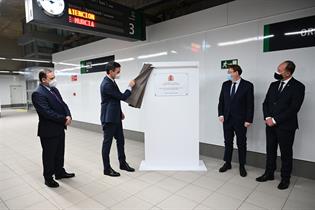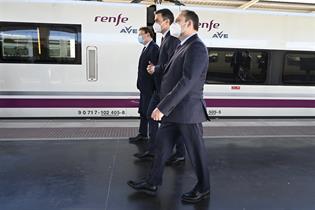During event to inaugurate high-speed connection between Monforte del Cid, Elche and Orihuela
Pedro Sánchez highlights government's commitment to cohesion and territorial structure
President's News - 2021.2.1
Images of the high-speed journey between Monforte del Cid, Elche and Orihuela | Pool Moncloa/Jorge Villar - 2021.2.1
Alicante
Decisive commitment to territorial structure
In his speech, President of the Government Sánchez highlighted the government's commitment to the field of infrastructures through projects that enhance the structure of the country, such as the stretch opened on Monday.
This stretch is part of the Madrid-Castile-la Mancha, Region of Valencia-Region of Murcia high-speed line, which, in turn, is part of the Mediterranean Corridor.
The President of the Government pointed to the value of this new infrastructure "in terms of territorial cohesion, since it will contribute to strengthen the economy of the region and of Spain as a whole in such important sectors as tourism, industry, agriculture and logistics".
In this regard, he highlighted the status of projects like this as genuine "State policies", recalling the "opportunity this represents for the transport of goods and the connection of logistics centres". He also pointed out that "social and territorial cohesion is one of the great strategic transformations being pushed through by the government, together with digitalisation, the ecological transition and equality between men and women".
2021, year of economic recovery
 Foto: Pool Moncloa/Borja Puig de la BellacasaAgainst this backdrop, he referred to the Recovery, Transformation and Resilience Plan, which is channelling the management of the 140 billion euros in European funds through these vectors, which is "the most ambitious economic reconversion project in the history of our country".
Foto: Pool Moncloa/Borja Puig de la BellacasaAgainst this backdrop, he referred to the Recovery, Transformation and Resilience Plan, which is channelling the management of the 140 billion euros in European funds through these vectors, which is "the most ambitious economic reconversion project in the history of our country".
The President of the Government highlighted the symbolic value of investment in infrastructures. "If mobility restrictions have helped protect people in this health emergency, the recovery of mobility, thanks to the vaccine, will make the economic reactivation possible in 2021". He then recalled the commitment of the National Budget to high-speed travel in the Region of Valencia, in such projects as the adaptation of international-gauge track on certain stretches.
New high-speed service
Renfe is starting up the high-speed Madrid-Elche-Orihuela service on 1 February with four daily journeys, two in each direction, between Madrid Puerta de Atocha and the Elche Alta Velocidad and Orihuela Miguel Hernández stations. The new high-speed service will offer a direct connection between Madrid and Elche in 2 hours and 10 minutes, while the stretch to Orihuela will be 2 hours and 22 minutes, with a daily offer of 1,264 seats.
In addition, Renfe is reorganising and extending the commercial offer of long-distance services between Madrid and the Region of Murcia. Accordingly, the high-speed trains that depart or arrive in Orihuela will connect with Carmen, Balsicas, Torrepacheco and Cartagena stations in the Region of Murcia with a shuttle service that guarantees this connection and accessibility throughout the line. The Ave + Lanzadera [high-speed shuttle] service from Orihuela will offer a connection between Madrid and Cartagena in 4 hours and 9 minutes, and between Madrid and Murcia in 3 hours and 9 minutes. Accordingly, the travel possibilities between the Region of Murcia and Madrid are increased, providing a free service to the Orihuela-Murcia-Cartagena stretch.
Stretch from Monforte del Cid to Orihuela
The stretch between Monforte del Cid, Elche and Orihuela - 48.4 km in total length - forms part of the 68.6 km that comprises the stretch from Monforte del Cid to Murcia, of which 52 km are situated in the province of Alicante and the rest in the Region of Murcia. There are hence barely 15 kilometres to be completed for the high-speed line to reach the city of Murcia. The two standard-gauge lines (1,435 mm) have been built from Monforte del Cid, passing through Elche AV, San Isidro-Albatera-Catral and Callosa de Segura-Cox (37 km) while provisionally one standard-gauge line and another conventional-gauge line (1,668 mm) will be built between Callosa de Segura and Cox, with access to Murcia, with a dual-gauge line (third lane) to be built in the access to the city of Murcia.
The whole stretch to Murcia is due to have a two-way standard-gauge line gradually introduced.
The construction works have included actions on six stations: Elche, San Isidro-Albatera-Catral, Callosa-Cox, Orihuela, Beniel and Murcia (currently under construction).
Mediterranean Corridor
 Foto: Pool Moncloa/Borja Puig de la BellacasaThis new line comes under the framework of the Mediterranean Corridor, which is an ambitious project that forms part of the European strategy to improve the competitiveness of the railway sector, and particularly to increase the share of railway transport in the field of goods transport.
Foto: Pool Moncloa/Borja Puig de la BellacasaThis new line comes under the framework of the Mediterranean Corridor, which is an ambitious project that forms part of the European strategy to improve the competitiveness of the railway sector, and particularly to increase the share of railway transport in the field of goods transport.
The Rail Freight Corridor 6 (Mediterranean Corridor) joins Spain and Hungary, crossing another four countries (France, Italy, Slovenia and Croatia) to the Hungarian border with the Ukraine.
This European corridor runs for more than 7,000 kilometres from Algeciras in Spain to Záhony in Hungary. One of the aims of the Mediterranean Corridor is to increase goods and passenger traffic both in medium- and in long-distance rail travel.
Non official translation





